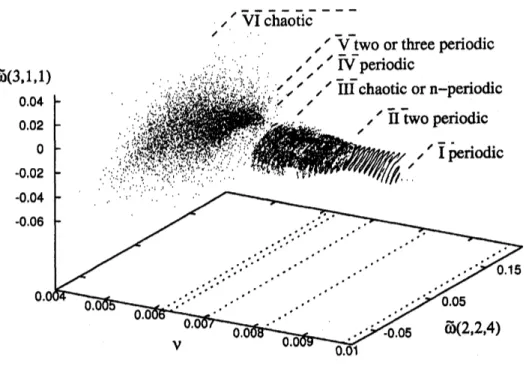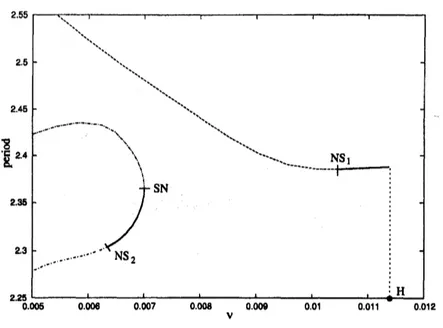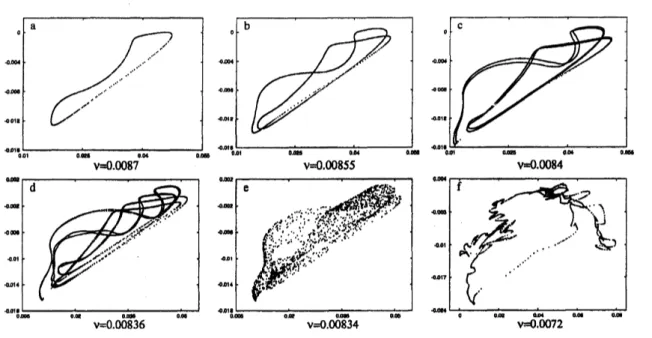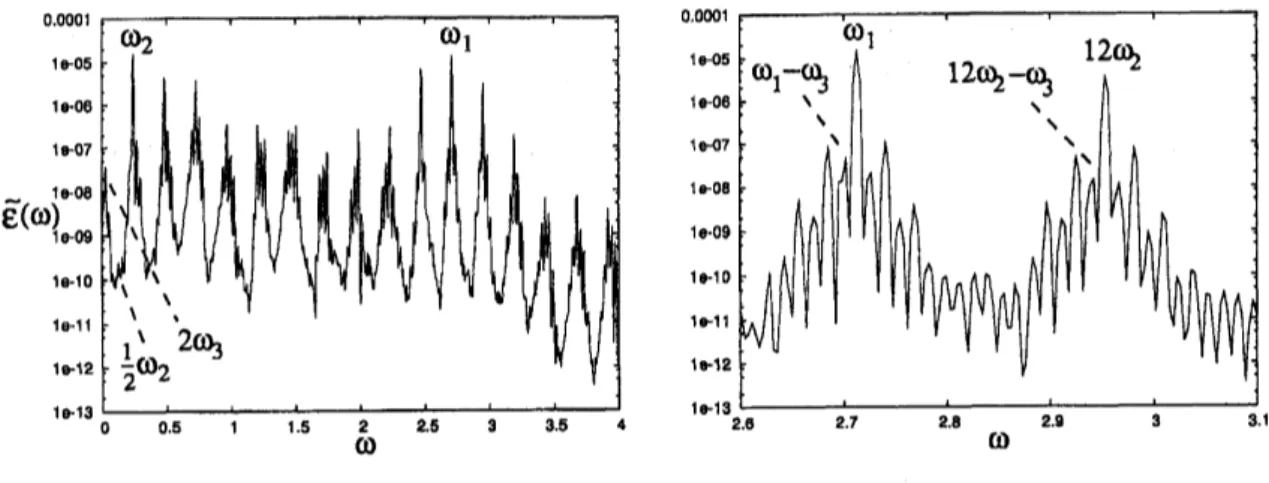Bifurcation
analysis
of the transition to turbulence
in
high
symmetric
flow
Lennaert
van
Veen,Kyoto University, Department of
Mechanical
Engineering
Email:
veen@mech.kyoto-u.ac.jpMarch
2,
2004
Abstract
Two scenarios leading to chaos and turbulence in high symmetric flow are de
scribed. Exploiting the symmetries and the divergence free conditionthe number of
degrees of freedom, and thereby the computational effort, is reduced by a factor of
about 300 compared to generaldirect simulation offluid flow. This allows for
bifur-cation analysis at the transition points. At the first transition a sequence of torus
doublings leads to temporalchaos, but the flow doesn’t become turbulent. At lower
viscositythe Ruelle Takens scenarioisfollowedandweareat the onsetof turbulence.
Some differences between these transitions are discussed in the light of bifurcation theory of invariant tori.
1
Introduction
Direct numerical simulation of flows at high Reynolds number requires solving large
sys-temsofdifferentialequations. Forthesolutions toberealistic the smallest resolvedspatial
scale should be ofthe
same
orderas
the typical size of the smallest vortices,a
fewtimes Kolmogorov’s dissipation scale. As the total number ofdegrees offreedom scalesas
thecubeofthe ratioof the largest to the smallest resolved scale the limitations ofmemory size and computation time
are soon
met. One way around this problem is to impose spatial symmetries onthe solutions.In the absence ofboundaries the incompressibleNavier-Stokes equations
axe
invariantunder translations$(\mathbb{R}^{3})$
,
rotations (SO(3)) and reflections$(\mathbb{Z}_{2}^{3})$.
InKida (1985) a subgroupofsymmetries consistingof three finite rotations and three reflections is imposed
on
thesolutions in aperiodic box. Interms of finite truncations in Fourierspace his reduces the
number of independentmodes by
a
factor ofabout 200. The resulting flow displays fully developed turbulencefor low viscosity, whereas onlya
few hundred degrees offreedomare
necessary to capture spatial scales small enough for reliable simulation. High symmetric
flow
was
subsequently used to explore the statistics of turbulent motion at moderateReynolds numbers (Kida
&
Murakami, 1989) and to find evidence for the Ruelle-Takens(1971) scenario at the transition from regular to chaotic motion Kida et al. (1989). In the latter paper a combination of forward time integration and power spectra
was
used tostudythetransitions. Three-periodic motion
was
showntooccur as
an
137
twice. At high viscosity temporalchaos
ensues
but the velocity profile remains simple. At lower viscosity vorticeson
smallscales developandturbulence sets in. Inthis workwe
will takea
closer look at the bifurcation scenarios leading to chaos and turbulence, focusingon
the differences between the transitions at high viscosity and low viscosity.Using bifurcation analysis, Poincare sections and power spectrawe show that at high viscosity
a
sequence oftorusdoubling bifurcations leads to chaos. Beyond this transitionthebehaviour alternates between periodic, quasi periodic and chaotic for small variations of viscosity. Reducing viscosity further
we
findan
intervalwithstableperiodic motion and then a second transition to chaos. Here, the Ruelle-Takens scenario is followed. Beyondthis transition point the flow starts to look turbulent
as
small scale vortices develop.The behaviour
near
the transition points is discussed in the light of bifurcation theory of invariant torias
presented in Broer et al. (1990).2
The vorticity equation for high
symmetric
flow
Consider
an
incompressible fluid ina
periodic box $0<x_{1}$,$x_{2}$,$x_{3}\leq 2\pi.$ In terms of theFourier representation of velocity and vorticity,
$\mathrm{v}=\mathrm{i}\sum_{\mathrm{k}}\tilde{\mathrm{v}}(\mathrm{k})\mathrm{e}^{\mathrm{j}\mathrm{k}}$
.,
$\omega$ $= \sum_{\mathrm{k}}\tilde{\omega}(\mathrm{k})\mathrm{e}^{\mathrm{i}\mathrm{k}}$ ” (1) we have $3\tilde{\omega}_{1}$.(k)$=\epsilon_{\dot{l}jk}k_{j}k_{l}$ $v\overline kvl-\nu 7$$2_{\tilde{\omega}_{i}}(\mathrm{k})$ $k_{i}\tilde{u}_{\dot{l}}=0$ $\tilde{\omega}_{\dot{l}}(\mathrm{k})$ $=$
-\epsilon ijk$k_{j}\tilde{v}*(\mathrm{k})$ (2)
where $\nu$ is the kinematic viscosity and the tilde denotes the Fourier transform. In terms
of the
standard
norm
energy and enstrophyare
given by$E= \frac{1}{2}||\mathrm{v}||^{2}$ $Q$ $= \frac{1}{2}||\omega||^{2}$ (3)
respectively.
Now consider the following discrete symmetry operations: Si, reflectionsin theplanes
$\mathrm{Z}$given by$x_{i}=\pi$and$R_{\dot{4}}$, rotations
over
$\pi/2$radiants about the lines$l_{i}$ : $Cj$ $=\pi/2\mathrm{f}\mathrm{o}\mathrm{r}j\neq i.$The periodic domain with planes of reflection
axes
of rotation is shown in figure (1).Supposethe$x$-componentofthe velocityfieldis given in the box $[0, \pi/2]$$\mathrm{x}[0, \pi/2]\mathrm{x}[0,\pi/2]$
.
Applying the symmetry operation $R_{2}\circ R_{3}$ yields the $y$-component and $(R_{2}\circ R_{3})^{-1}$ the $\mathrm{z}$-component in that box. Subsequently $R_{1}$, $R_{1}^{2}$,$R_{1}^{3}$, $R_{2}^{2}$, $R_{2}^{3}$, $R_{3}^{3}$ and $R_{1}^{2}\circ R_{3}$ yield the
velocity field
on
thebox $[0, \pi]$ $\mathrm{x}[0,\pi]\cross[0,\pi]$ andfinally the reflections $S_{1}$, $S_{2}$, $S_{2}\circ S_{1}$, $S_{3}$, $S_{1}\mathrm{o}S_{3}$, $S_{2}\circ S_{3}$ and $S_{1}\circ S_{2}\circ S_{3}$ fill up the whole periodicdomain. Thus onlyone
out of three components ina
volumefraction $1/4^{3}$ determines the wholeflow, whichreduces thecomputational effort by
a
factor 192. The divergence free condition ismore
conveniently handled in Fourier space.Symmetry operations $S_{}$ and$R_{i}$ introduce linear relations between the Fourier
comp0-nents of vorticity. First of all
we
have$1_{3}$
$(0,0,\pi)$ $(0.\pi, )$ $(0.0.2\pi)$ $(0.2\pi.2)$
$—’-’$
’-I–
$(\pi 0,\pi)$ $(2\pi.0.2\pi)$ 1 \prime\prime\prime 1
1 1 $\mathrm{v}_{2}$ 1 1 .$\cdot$. $\cdot$. $\cdot$. $1_{2}$ $-’-_{\mathrm{I}}^{1}--’ \int_{1\prime}’\overline{\mathrm{v}_{3}}^{---}----$ $– \frac{1}{\prime\prime \mathrm{r}\mathrm{I}},$ $-’-[$ : : $1_{1}$ 1 1 $.\cdot.\cdot.\cdot\ldots\ldots\ldots\ldots$ .. $\cdot.\cdot.\cdot$ . $(0.\pi 0)$ $|--\mathrm{I}\llcorner’-\prime \mathrm{I}\prime r--$ \prime\prime – $\mathrm{I}\mathrm{I}$ (0.2.0)
$(\pi,0.0)$ $(\pi$
.
.0$)$ $(2\pi,0,0)$ $(2\prime 2\pi,0)$Figure 1: Left: the domain $[0, \pi]$ $\mathrm{x}[0,\pi]\mathrm{x}[0, \pi]$ with theaxes ofrotation $l_{1,2}$,s drawn in. Right:
the domain $[0, 2\pi]$ $\mathrm{x}[0,2\pi]\mathrm{x}[0,2\pi]$with the planesof reflection $V_{1,2,3}$drawnin. If
one
componentof the vorticityfieldisspecifiedin the boxdelimited by thedottedline, thefullfieldontheperiodic
domain follows from symmetry.
so
thatwe
may consider onlyone
component. This scalar function iseven
or
odd in itsarguments:
$\tilde{\omega}1(k_{1}, k_{2}, k_{3})=\tilde{\omega}1(-k_{1}, k_{2}, \mathrm{c}_{3})=-\tilde{\omega})(k_{1}, -k_{2}, k_{3})=-\tilde{\omega}1(k_{1}, k_{2}, -k_{3})$ (5) and finally
we
have$\tilde{\omega}_{1}(k_{1}, k_{2}, k_{3})=\{$
$-\tilde{\omega}_{1}(k_{1}, k_{3}, k_{2})$ for $k_{1}$ and $k_{2}$ and$k_{3}$ even,
$\tilde{\omega}_{1}(k_{1}, k_{3}, k_{2})$ for $k_{1}$ and $k_{2}$ and $k_{3}$ odd,
0otherwise.
(6)
We consider
a
cubic truncation, i.e. $|k1,2,3|\leq N.$ Relations $(4)-(6)$ reduce the number ofindependent Fourier modesofvorticity by
a
factor of192
in the leading order, that is $N^{3}$.
There is, howeverone more
linear relation which allows for further reduction, namely the divergence free condition for vorticity. With the aidofrelation (4) it reads$k_{1}\tilde{\omega}_{1}(k_{1}, k_{2}, k_{3})+k_{2}\tilde{\omega}_{1}(k_{2}, k_{3}, k_{1})+k_{3}\tilde{\omega}_{1}(k3, k_{1}, k_{2})=0$ (7)
Taking maximal advantage of relations $(4)-(7)$ weconsider only Fourier components of$\omega_{1}$
in the fundamental domain $\{\mathrm{k}\in l^{3}|k_{3}>k_{2}, k_{3}\geq k_{1}, k_{1}\geq 0, k_{2}>0, k_{3}\leq N\}$
.
A sketchof this domain is shown in figure (2). The number ofindependent modes is reduced by
a
factor of288 in the leading order. These components satisfy the following equation
$\frac{\mathrm{d}}{\mathrm{d}t}\tilde{\omega}_{1}(k_{1}, k_{2}, k_{3})=k_{2}k_{3}(\tilde{S}(k_{3}, k_{1}, k_{2})-\tilde{S}(k_{2}, k_{3}, k_{1}))+k_{1}k_{2}\tilde{T}(k_{2}, k_{3}, \mathrm{c}_{1})$
$-k_{3}k_{1}\tilde{T}(k_{3}, k_{1}, k_{2})+(k_{2}^{2}-k_{3}^{2})\tilde{T}(k_{1}, k_{2}, k_{3})$ $-\nu k^{2}c\tilde{\omega}_{1}(k_{1}, k_{2}, k_{3})$ (8)
where $\tilde{S}$
and $\tilde{T}$
are
theFourier transforms of138
$\ulcorner_{1}^{\mathrm{k}_{2}}|\mathrm{i}.\cdot.\cdot..\cdot\cdot.\cdot\cdot.\cdots\backslash |\dot{\mathrm{o}}\cdot\cdot i|.\cdot\cdot\cdot.\cdot...\cdot..\cdot$
. $(0,0,.\cdot..\cdot 4.)|..\cdot\cdot.\cdot.\mathrm{i}_{0}.\cdot..\cdot.\cdot i.\cdot$
..
$\cdot$.-...
$\cdot$ $(0,0_{\mathrm{I},1’},.5..)|..\cdot.\cdot|.\cdots.,|.\cdots\cdot..\cdot.\cdot.1||\dot{\mathrm{o}}\cdot\cdot\dot{}\cdot\cdot\dot{\mathrm{o}}\ell\cdot\cdot..\cdot\cdot.\cdot.\cdot.\cdot.||’.||.\cdot$.
$(0,0_{1},...6..)\mathrm{I},.\cdot\cdot.\cdot.\cdot..\cdot$..
$\cdot.\cdot\cdot.\mathrm{Q}.\cdot.\cdot\cdot\cdot\cdot\cdot\ldots|\cdots||...\cdot$. $\cdot$ $...\cdot...\cdot.\cdot..\cdot\cdot.\backslash \cdot.\cdot$. $\mathrm{k}1$ $||\ldots$.$\cdot\ldots\ldots$.: $.\cdot..\cdots.\mathrm{I}.\cdot..\dot{.\cdot}...\cdot$.
$\cdots\cdot.\cdot$
.
$|.\cdot\ldots.||.\cdot.\cdots...\cdots\cdot.\cdot\ldots..\cdot.\ldots..\cdot.\cdot$ $.\cdot.\cdot\ldots..\cdot.\cdot.$.(...
$\cdot$$\cdot$;
$\cdot\cdot \mathrm{O}^{\iota}\cdots.\cdot..\cdot\ldots i.$
.
$|.\cdot\ldots \mathrm{k}_{3}.=.3i.\cdot.\cdot$
...$(.\cdot.3,3,3)$
$.\cdot.\cdot...\cdot.\cdot.\cdot.|||.\cdot..\cdot.\cdot\dot{}’.\cdot.\cdot.\cdot.\cdot.i..\cdot.\cdot.\cdot.\cdot..\cdot$
.
$|\cdots 0\cdot$.$|\cdot\cdot 2$..$..\cdot.\cdot\ldots..\cdot.\cdot$
$.\cdot.\cdot.\cdot..\cdot.\cdot.\cdot.\cdot.\cdot.\cdot..\cdot.\cdot.\cdot.\dot{\oplus^{\backslash }}.\cdot\cdot..\cdot|\cdot..\cdot\cdot||\dot{\mathrm{Q}}|..\cdot.\cdot.\cdot.\cdot||.\cdot\cdot\cdot.\cdot.\cdot.\cdot’.\cdot\cdot$
..
:....:$\ldots$$\{$$\cdots j\cdots.\cdot\ldots.:1$
$\mathrm{k}_{3}4$ (4,4,4) $|\mathrm{i}$ ..$.!^{\iota}$. . $i|$ . .$\dot{\mathrm{o}}$
..
..$\cdot$.
$\cdot$ . . . .$\cdot$.
$\cdot$ $.\cdot.\cdot\ldots..\cdot.\cdot\ldots \mathrm{j}\ldots|‘$.
$\ldots|i||..\cdot.\ldots.|.\cdot.\cdot\ldots...\cdot$.
(5,5,5) :$\mathrm{k}_{3}=5$ $\ldots$.1$..\cdot\cdot|\ldots 6\ldots$$.|.\ldots(.\cdot 6,6,6)$
$\mathrm{k}_{3}=6$
Figure 2: Wave vectors corresponding toindependent amplitudes$\tilde{\omega}_{1}(\mathrm{k})$
.
Shown arethe firstfourlevelsin $k_{3}$, starting at the smallestwavevector$\mathrm{k}=(1,1,3)$
.
Solid: odd sub lattice. Open: evensub lattice. and
$k^{2}\tilde{v}_{1}=k_{2}\tilde{\omega}_{1}(k_{3}, k_{1}, k_{2})-k_{3}\tilde{\omega}_{1}(k_{2}, k_{3}, k_{1})$ (10)
Energy in supplied by fixingthe low order odd mode $\tilde{\omega}1(1,1,3)=-3/8$
.
Thuswe
obtaina
family ofdynamical systems withone
parameter, $\nu$, anda
number of degrees offfeedomgiven by $n(N)=\{)$ $\frac{2}{\frac{32}{3}}(+(\frac{\frac 2N)^{3}N-1}{2})^{3}\frac{1}{+2}(\frac{N}{2(})\frac{7}{\%}\frac{N}{2-}\frac{3}{2}\frac{N-12-}{2})\frac{1}{6}(\frac{N-1}{2})$ if$N$ is odd if$N$ is
even
(11)3
Numerical considerations
Inperformingtime integrations
we
avoid theuse
of thepseudo spectral methodcommonly employed forthreedimensional simulations. Dueto thereduction ofthe number of degreesof freedom the direct method is not much slower and yields
a
simple, transparent codeand easy
access
to the Jacobian for integration of the linearised system. The code is composedof twoparts. First, all nonlinear interactioncoefficientsare
computed fora
giventruncation level $N$
.
This is done by loopingover
all resonant triads fora
given Fouriercomponent and mapping all resonant modes onto thefundamental domainby symmetries $(4)-(6)$ and relation (7). This process takes up to a few minutes for truncation levels up
to $N=21,$ the highest resolution considered in Kida et al. (1989). After that
a
seventhto eighth order Runge-Kutta-Felbergh scheme with step size adjustment is employed for integration. The
use
ofa
high order method mightseem
odd for such large systems butas
it turns out that the step size adjustmentmore
than makes up for the larger numberof
evaluations of the vector field,13
compared to4
forfourth-0rder
Runge-Kutta.The following experiment
was
done to check this. Ifwe
do not fix $\overline{\omega}1$(1, 1, 3) in timeand set $\nu=0$ kinetic energy $E$ is conserved. The fourth-0rder and high order Runge
Kutta method
were
employed to integrate the conservative systemover
an
interval $\Delta t$muchlarger than the typical time scale offactuations, whichis$\mathrm{O}(1)$
.
Theerror
tolerancefor the energy conservation
was
fixed to $\kappa\sim$.
For the high order method this is done byspecifying the local
error
tolerance, for $\mathrm{t}\mathrm{h}.arrow\underline{!}\gamma \mathrm{w}$ ordermethod by choosing asmall enough$0\mathfrak{l}$ 01 $\mathrm{V}-$ .00836 $\mathrm{v}=0.0$ 153 01 $00$’ 0 ’ $\mathrm{Q}\eta 0$ , 0 ’
.
’.
1 0 0 0 0 0 ’ 1 ’ 0 0 0 0 $0S$ 1 kn knFigure 3: Band-averaged enstrophy spectra near the transitions to chaos (see section (4)). Ob
tainedfrom anintegrationof$10^{3}$ timeunits, $\log$-linear scaleinnormalised units. Left: atthefirst
transition, $\mathrm{I}\mathrm{I}arrow \mathrm{I}\mathrm{I}\mathrm{I}$ infigure (4). Right: at the second transition,$\mathrm{V}arrow \mathrm{V}\mathrm{I}$
.
the average step size of the high order method is about ten times the required step size
of the low order method. As many ofthe results presented here
are
basedon
rather long time integrations it importantto keep theerror
tolerancelow. The seventhtoeighthorderlong -Kutta-Felbergh scheme has been shown to be extremely reliable,
see
for instanceTuwankotta
&
Quispel (2003), where this scheme is shown to beas
accurate as, albeitslower than, problem-specific symplectic methodsin a nearly integrableproblem.
Below simulations
are
performed witha
viscosity in therange
$0.004<\nu<0.01$ and thetruncation level fixed to $N=15.$ We computed theenergyand the enstrophy,as
wellas
Taylor’s micr0-scale Reynolds number, $R_{\lambda}$,
and Kolmogorov’s dissipation length scale, $\eta$, defined by$R_{\lambda}= \sqrt{\frac{10}{3}}\frac{E}{\nu\sqrt{Q}}$ $\eta=\sqrt[4]{\frac{\nu^{2}}{2Q}}$ (12)
As
a
rule of thumb the ratio $\eta||k||_{\max}$ has to be $0(1)$ for the truncationerror
to benegligible. In the viscosity rangeexploredhereit variesintherange$1.3>\eta||k||_{\max}>$
0.63.
Tomakesure
the truncation level is high enough to describethe transitions to chaos, the focus of this research,wecomputedthe band-averaged enstrophy spectra at the transitionpoints, they
are
shown in figure (3). At thesmall scalesan
exponential decay is visible,indicating that
our
numerical resultsare
reliable. Thetime average micr0-scale Reynolds number varies from $R_{\lambda}\approx 55$to $R_{\lambda}\approx 27,$ indicating that onthe lower end of the viscosityscale
we are
at theonset of turbulence.In addition to time integration
we
appliednumericalbifurcation
analysis to thissystem.For thisend
we
use
the software packageAUTO
(Doedel et$\mathrm{o}\mathrm{Z}.$, 1986). This software is notdesigned to handlelarge systems and
a
scaling needs to be introduced for computation of141
Figure 4: Limit point diagram intherange$0.01>\nu>$ 0.004. Visibleisthetransition$\mathrm{I}arrow \mathrm{I}\mathrm{I}$ from
periodic to quasi periodic, $\mathrm{I}\mathrm{I}arrow \mathrm{I}\mathrm{I}\mathrm{I}$ to chaotic, $\mathrm{I}\mathrm{I}\mathrm{I}arrow \mathrm{I}\mathrm{V}$back to periodic, $\mathrm{I}\mathrm{V}arrow \mathrm{V}$ to quasiperiodic
and $\mathrm{V}arrow \mathrm{V}\mathrm{I}$ to $\mathrm{c}\mathrm{h}\mathrm{a}\mathrm{o}\mathrm{t}\mathrm{i}\mathrm{c}/\mathrm{t}\mathrm{u}\mathrm{r}\mathrm{b}\mathrm{u}\mathrm{l}\mathrm{e}\mathrm{n}\mathrm{t}$
.
In region $\mathrm{m}$the behaviour alternates between chaotic and twoor
threeperiodicwhile the spatialstructure of the flow remainssimple.4
Transitions to
chaos and
turbulence
The focus of the present paper is the transition from regular to chaotic and turbulent behaviour for decreasing viscosity. In Kida et al. (1989) two and three periodic motion
was
found which implies that the Ruelle-Takens scenario is followed. Itwas
also shown that, afteran
initial transition to temporal chaos regular (periodic) motion sets in. $\mathrm{A}\mathrm{f}rightarrow$ter
a
second transition the spatial behaviour becomesmore
complicated and turbulencedevelops. That work
was
mainly basedon
forward time integration, power spectra andmeasurement of the micro scale Reynolds number. In addition to these instruments
we
employ bifurcation analysis to take
a
closer look at the transitions.For large viscosity
an
equilibriumstate is the global attractor for this system. At /830.0113 a
Hopf bifurcationoccurs
inwhicha
stableperiodic orbit is created. To geta
firstimpressionof thetransitions from periodicity to chaoticandturbulent motionwecomputed
a
limit point diagramintherange$0.01>\nu>$0.004
ofthePoincare mapon
the plane givenby$\tilde{\omega}(0,2,4)=$ 0.005. Theintegration time
was
$\Delta t=1000$ for each parameter value, aftera
transient time of 100 time units, using the last point at the previous viscosityas
initialvalue. The limit pointdiagram isshown in figure(4). Two parameter ranges with periodic
behaviour
can
beseen: one
for $\nu>$ 0.0105 andone
around $\nu=$ 0.0068. A continuation$\mathrm{z}_{2\mathrm{a}\mathrm{s}_{\mathrm{r}50\mathrm{o}\mathrm{e}\alpha}}\Leftrightarrow.\ovalbox{\tt\small REJECT}_{0\mathrm{o}\mathrm{e}\mathrm{o}0\mathfrak{g}}\mathrm{a}_{\mathit{1}^{1}}235\mathit{3}^{\cdot}$.
$|||\mathrm{I}||1|$
2
Figure 5: Continuationof two branches ofperiodic solutions,
one
created in Hopfbifurcation$\mathrm{H}$andonenot connected to abranch ofequilibria. Periodversusviscosity. Thicklines denote stable
orbits, thinlines unstableorbits. SNdenotes asaddle node bifurcation andNS aNeimark-Sacker
(torus) bifurcation.
around$\nu=$
0.0068
doesnotbifurcatefroman
equilibrium. Bothbranches become unstablein
a
Neimark-Sacker,or
Torus bifurcation. Directly beyond thesebifurcation
pointswe
expect the behaviour to be quasi periodic, and indeed invariant circles
appear
in thePoincare section, figure (4). The transitions which
occur near
bifurcation points NSi and$\mathrm{N}\mathrm{S}_{2}$
are
different andlead to different behaviour. Inthe following sectionswe
willdescribethe breakdown of the invariant tori in
more
detail.4.1
The
first
transition to chaos: torus
doubling
bifurcations
As can be
seen
in figure (4) quasi periodicmotion persistsover a
large parameter range totheleft of bifurcation point$\mathrm{N}\mathrm{S}_{1}$
.
Theoreticallywe can
expectthe quasi periodicbehaviourto persist
on a
ffactal domain in parameter space,as
proven in Broer et al. (1990)(part$\mathrm{I})$
.
Therefore we mightsee
many transitions. Indeed, to the left of $\mathrm{N}\mathrm{S}_{1}$ we find periodic(phase-locked) motion, $3arrow \mathrm{p}\mathrm{e}\mathrm{r}\mathrm{i}\mathrm{o}\mathrm{d}\mathrm{i}\mathrm{c}$ motion (as reported
on
inKida et al. (1989)) and chaos.Transitions betweenthese regimes
can
berelated to bifurcations ofphaselocked orbits,as
shown in Broer et al. (1998),
or
rather to bifurcations of the torus itself. In Broer et al.(1990) (part $\mathrm{I}\mathrm{I}$
)
a
partialtheoryof bifurcating toriisdeveloped. In particular quasiperiodicsaddle-node, period doubling and Hopfbifurcations
are
shown tooccur
generically ifone
parameter is varied. The quasi periodic Hopf bifurcation corresponds to
a
transition to3-periodicmotion, whereas the quasi periodicperiodicdoubling (ortorusdoubling) results either in two new, disjunct tori
or
inone
new
torus withone
period doubled. The latterbifurcation shows up in
our
system.The first transition ffom quasi periodic to chaotic is shown in figure (6). The torus doubles at least three times before
a
chaotic attractor shows up. Cascades of torusdou-143
$\infty 4M4M$
*D
$\nearrow’,\nearrow’\mathrm{r}’,\alpha$
$\varpi$
$\triangleleft \mathrm{n}\mathrm{a}\triangleleft m\mathrm{r}_{\rho}M\ovalbox{\tt\small REJECT} \mathrm{m}$’
$J’r^{\nearrow’}u$
$\mathrm{r}$
$\tau \mathrm{r}\triangleleft \mathrm{r}*\ovalbox{\tt\small REJECT}_{\mathrm{o}\mathrm{r}}^{l}\alpha \mathrm{r}_{0\mathcal{M}\mathrm{R}U}4M\mathit{0}$
400 -000 400
$\mathrm{R}$
$\omega \mathrm{r}_{4}\alpha \mathrm{m}\mathrm{c}\mathrm{r}\mathrm{n}\mathrm{r}\prime \mathrm{e}_{\delta}\not\in^{p}\xi_{\beta_{\mathrm{g}^{\vee}}^{\vee}}^{_{}}.\backslash \cdot\prime^{\acute{\{}_{}\prime}.\cdot\dot{j}_{*}..\cdot.\cdot..\cdot.\cdot,\cdot.\dot{t}’_{\mathrm{B}}..’$
.
$\wedge,\cdot.t_{\acute{k}^{*\cdot\acute{}},’}^{j_{\backslash }^{_{\grave{\acute{|}j}’i}}}\dot{.}_{_{l^{\backslash },.\backslash .,},j\cdot,i\dot{j}^{\acute{\mathrm{v}}_{}}}..\cdot..\cdot\cdot..\cdot._{\mathit{3}}..\cdot..\cdot..\cdot...\cdot..i‘.\cdot..\cdot\cdot\sim’.f_{i\cdot!}\acute{\dot{\nu_{\mathrm{s}_{\sim}\mathrm{b}}^{\backslash .\mathrm{e}_{\vee}}|}}\cdot,.\cdot..\cdot\dot{.}’...\cdot.f_{i_{\mathrm{Y}_{\backslash }}^{4}}.’\cdot,i_{\dot{\mathrm{r}}}.\cdot..\cdot_{*}...\ovalbox{\tt\small REJECT}^{\sim.\dot{\Psi}}..\cdot\acute{..1\cdot.}’\oint_{}..|.i.\grave{P}^{\mathrm{t}}$
.
$\triangleleft\rho\prime 0^{\cdot}M$
$0\alpha$
$\mathrm{v}=0.0^{\mathrm{o}\mathrm{m}}0834$
$\mathit{0}oe$
Figure 6: Poincare sections near bifurcation point $\mathrm{N}\mathrm{S}\mathrm{i}$. Integration time for each picture was
$\mathrm{O}(10^{3})$
.
Prom a to $\mathrm{d}$ the invariant torus doubles three times whereas the motion remains quasiperiodic. At $\nu=$0.00834, picture$\mathrm{e}$,the motion hasbecome chaotic. Reducing theviscosityfurther
the torus reappears. In picture $\mathrm{f}$it seems to be near breakdown.
$\mathrm{C}*\ovalbox{\tt\small REJECT}_{0\mathrm{J}}^{0)}\ovalbox{\tt\small REJECT}^{\omega_{2}}\ovalbox{\tt\small REJECT}\ovalbox{\tt\small REJECT}_{\delta 01}^{\omega}\epsilon_{06}\epsilon\epsilon- \mathrm{a}48\mathrm{e}\alpha_{\mathrm{k}}-054\ovalbox{\tt\small REJECT}\ovalbox{\tt\small REJECT}\mathrm{I})2$ $\tau_{\mathrm{P}}\triangleright \mathrm{e}03\triangleright\alpha 09\triangleright\triangleright oe\triangleright_{s\mathrm{a}}\epsilon-3\mathrm{o}\mathrm{e}\ovalbox{\tt\small REJECT}_{3}^{\omega_{2}}\ovalbox{\tt\small REJECT}\ovalbox{\tt\small REJECT}^{01}0)\mathit{0}1_{\mathrm{C}0}$
$0\mathrm{s}$ $25\mathrm{c}\mathrm{r}$
Figure 7: Energy spectrum obtained from an integration with $\nu=$ 0.00834 and $\Delta t=4\cdot$ $10^{3}$
.
Onthe left: low frequency domain withfundamental ffequency $\omega_{2}$ and harmonics
$\omega_{2}/2^{k}$
.
On theright: highfrequency domainwith fundamental frequency$\omega_{1}$ andsomecombination peaks.
blings
were
reportedon
long before the normal form theorywas
developed, e.g. Kaneko(1983); Franceschini (1983); Anishenko (1990). In spite of attempts to develop scaling
and normal form theory,
as
in Kaneko (1984); Arneodo et al. (1983), those studieswere
mainly phenomenological and led to the conjecture that, in contrast to doublingcascades
of periodic orbits, only a finite number of torus doubling
can occur
before the torus is destroyed and chaosensues.
Figure
8:
Poincare sections near bifurcation point $\mathrm{N}\mathrm{S}_{2}$.
Integration time for each picture was$\mathrm{O}(10^{3})$
.
Fromato$\mathrm{b}$we seetheinvariantcircledoubleonce
but in$\mathrm{c}$athirdfundamentalffequency
has appeared in a quasi periodic Hopf bifurcation. In picture $\mathrm{d}$ the three periodic motion has
broken down and chaos isobserved. Note, that the scales have been adjusted.
value $\nu=$0.00836, corresponding to Poincar\’e section $(6\mathrm{d})$
.
Frequency $\omega_{1}$ lies close to theperiod of the orbit that is stable for $\nu>$
0.0105.
In the low frequency range the otherfundamental frequency, $\omega_{2}$ is shown. The peaks at $\omega_{2}/2^{k}$ for $k=1,2,3$
are
due to therepeated period doubling. These harmonics also show up in combination peaks,
as
shownaround $\omega_{1}$
.
4.2
The
second transition to
chaos: quasi periodic
Hopfbifurcation
Stable
quasi periodic motion is again found beyond bifurcationpoint $\mathrm{N}\mathrm{S}_{2}$ (see figure (5)).The corresponding invariant circle of the Poincare map is shown in figure (8a). If we
decrease the viscosity we first observe
a
torus doublingas
described above. The double invariant circle isshown in figure (8b). However, subsequent doublingbifurcationsare
notfound. Insteadfor slightlylower viscosity
we
findthree periodic motion. A quasi periodic Hopf bifurcation has occurred anda
third fundamental ffequency has been created. The three dimensional torus shows up in the Poincar\’e sectionas a
thick invariant circle,see
figure $(8)\mathrm{c}$
.
Aswasshown byRuelle&
Takens (1971) the threeperiodicmotion is unstableto perturbations and if
we
decrease viscosity furthera
chaotic attractor shows up $(8\mathrm{d})$.
Thus, the second transition to chaos follows
a
scenario different from the firstone.
The energy spectrum for three periodic motion is shown in figure (9). The first
fun-damental frequency, $\omega_{1}$, is again related to the period ofthe orbit from which the torus
145
0 01 2 1 1 05 1 0 ’ 07 0 1 1 12 ’ 5 1- 12 1 06$\backslash \backslash \backslash$
$\backslash \backslash \backslash \backslash$ $1$ $7$ $\tilde{\epsilon}()11$ $-$ $\backslash \backslash$ ,-08 .09 1 $-\prime 0$ $\backslash$ 110 $\backslash$ $\backslash$ e-1I $\mathfrak{j}\mathrm{t}\mathrm{t}$ 1 $2 $\frac{1}{2}\backslash 22$ ’ $\dagger 2$
1130
0. 1 15 2 .5 .5 4 ’12
2.7 $B$ 2.9 3 31Figure 9: Energy spectrum obtained ffom an integration with $\nu=$ 0.00834 and $\Delta t=4\cdot$ $10^{3}$
.
O$\mathrm{n}$theleft: low frequency domain with fundamental frequency$\omega_{2}$ and harmonics
$i_{2/2^{k}}$
.
On theright: high frequency domainwith fundamental frequency$\omega_{1}$ and somecombination peaks.
weak, at $\omega_{2}/2$ due to the doubling bifurcation. The third fundamental frequency, $\omega 3$
,
isfairly small but
we can see
its harmonics.On
theright hand sidean
enlargement around$\omega_{1}$ is shown. The system is
near
1 :11resonance
so
that thepeaksat$11\omega_{2}$ and$\omega_{1}$ almost
coincide. Combination peakswith the third fundamental frequency
are
shown around $\omega_{1}$and $12\omega_{2}$
.
5
Conclusion
Takingfull advantage of the symmetries anddivergence ffeecondition we have simulated
high symmetric flow at micro scale Reynolds numbers in the range $R_{\lambda}\approx 27-55$
.
Asreported in Kida et al. (1989),
we see
intervals with stable periodic motion in this range,followed by
a
transitionto quasi periodicand, subsequently, chaotic motion fordecreasingviscosity. By the
use
of bifurcation analysis, Poincaresections andpowerspectrawe
haveshownthatthese transitions
are
different in nature. Thefirst transition to chaos is due toa sequence
of torusdoublingbifurcations. The theory ofsuchcascades isas
yet incompleteand scaling laws similar to those for doubling cascades of periodic orbits haven not been
derived. The impression ffom numerical
simulations
andexperiments is that onlya
finitenumber of torus doublings
can occur
before chaosensues
(Arn\’eodo etal., 1983; Anishenko,1990). In
our
systemwe
observe three doublings, but further integrations might revealmore
doubling bifurcations, which would contributeto the formulation ofscaling laws. Ifwe
decrease viscosity beyond the first transition pointwe
findan
interval inpa-rameter space with many transition between periodic, quasi periodic and chaotic motion. This is in agreement with the theory formulated by Broer et al. (1990), which says that quasi periodic motion will be stableon afractal set in parameterspace. Inthis region the spatial structure of the flow remains simple andonly large scale vortices arise.
Thesecond transitionis shown to follow the
Ruelle-Taken
(1971) scenario, periodic $arrow$?tw0-periodic $arrow$threeperiodic$arrow$?chaotic. Poincar\’esections showthat
a
chaoticattractor isprocess. This attractor persistsfordecreasing viscosityasthe microscale Reynolds number exceeds 50 and turbulent motion sets in.
The difference in behaviour beyond the transition points through quasi periodic
dou-bling and quasi periodic Hopfbifurcationsleads tothe hypothesis thatquasi periodic dou-bling might induce temporal chaos but not turbulence, whereas the quasi periodic Hopf bifurcation, introducing
an
extra fundamental frequency,can
lead to turbulent motion.Infutureworkcontinuationof periodic orbitsto lowviscosity will be performed, hoping
to find periodic orbits
embedded
in the turbulent attractor.6
Acknowledgments
I would like tothank theNationalInstitute for FusionSciencein Toki, Japan, for thetime Ispent workingthere, ShigeoKida, GentaKawahara, HenkBroer and Eusebius Doedel for useful discussionsandGreg Lewisforhis hospitality at theUniversity ofOntario Institute
of Technology. This work
was
supported bythe Japan Society for Promotion ofScience.References
ANISHENKO, V.S.
1990.
Complex oscillations in simple systems. Nauka, Moskow.ARN\’EODO,
A., COULLET, P.H.,&
SPIEGEL, E.A. 1983. Cascade ofperiod doublingsoftori. Phys. Lett. A, 94, 1-6.
BROER, H. W., Sim6, C.,
&
TATJER, J. C. 1998. Towardsglobalmodelsnear
homoclinic tangencies ofdissipative diffeomorphisms. Nonlinearity, 11,667-770.
BROER, H.W., G.B., HUITEMA, TAKENS, F.,
&
BRAAKSMA, B.L.J. 1990. Unfoldingsand bifurcations ofquasi-periodic tori. $Mem$
.
$AMS$, 83(421). DOEDEL, E. 2003. Private communications.DOEDEL, E., CHAMPNICYS, A., FAIRGRIEVE, T., Kuznetsov, Yu. A., SANDSTEDE,
B.,
&
WANG, $\mathrm{X}.\mathrm{J}$.
1986.
AUTO97.
$\cdot$Continuation
andbifurcation software for
ordi-navy
differential
equations (with HomCont). Computer Science,Concordia
University,Montreal, Canada.
FRANCESCHINI, V. 1983. Bifurcations oftori and phase locking in
a
dissipativesystemofdifferentialequations. Physica $D$, 6,
285-304.
KANEKO, K. 1983. Doubling of torus. Prog. Theor. Phys., 69,
1806-1810.
KANEKO, K. 1984. Oscillation and doubling of torus. Prog. Theor. Phys., 72, 202-215.
$–\cdot\cdot\wedge\vee-\cdot\backslash \vee$’ -\sim . $\wedge\cdot\vee\wedge\cdot\vee\cdot\vee\wedge\wedge\wedge-\cdot\cdot\vee\cdot-\cdot\cdot-\veerightarrow\vee-\vee\wedge\cdot\cdot\wedge\Leftrightarrow\vee\wedge\cdot\vee\wedge-\cdot\cdot\wedge\cdot\cdot s\cdot\wedge’\vee\cdot\vee\cdot\cdot\wedge’ yy\cdot\cdot$, $.rightarrow’rightarrow\cdotrightarrow--\cdot$
.
KIDA, S. 1985. Three-dimensional periodic flows with high-symmetry. J. Phys. Soc.
Japan, 54(6), 2132-2136.
KIDA, S.,
&
MURAKAMI, Y. 1989.Statistics
ofvelocity gradients in turbulence at147
KIDA, S., YAMADA, M.,
&
OHKITANI, K. 1989. A route tochaosand turbulence. Physica$D$, 37, 116-125.
RUELLE, D.,
&
TAKENS, F. 1971. On the nature of turbulence. Commun. math. Phys.,20,
167-192.
TUWANKOTTA, J. M.,
&
QUISPEL, G. R. W.2003.
Geometric numerical integrationapplied to theelastic pendulum at higher-0rder
![Figure 1: Left: the domain $[0, \pi]$ $\mathrm{x}[0,\pi]\mathrm{x}[0, \pi]$ with the axes of rotation $l_{1,2}$ ,s drawn in](https://thumb-ap.123doks.com/thumbv2/123deta/6014787.1064403/3.892.158.770.162.391/figure-left-domain-mathrm-mathrm-axes-rotation-drawn.webp)






